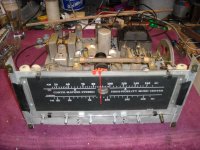Is anyone familiar with these? I did a search and go t only one hit on a SS version.
It appears that late in their production they made one chassis that was used in the TV console and the stereo console. The one I scored today ($32.00) is a console stereo, but there is an input jack on the chassis for TV.
All the tubes are marked Curtis Mathes, Japan.
I slowly brought up the B+ on the caps to see if they would reform, and they looked good so I did the light bulb and variac power up. Everything looked good so I tried the FM stereo and it locked in to a strong station, but is a bit distorted.
With the selector on tape no input and the volume on max the hum is not too bad. B+ at first stage is 350, with 325 on the plates of the (SE) 6BQ5s. Ripple on the first filter cap is 4Vrms, with 0.3Vrms on the next filter, and less than 10mVrms on the two final (it splits) caps.
I connected a CD player to the tape input and it sounded much better.
It is nice that it is an integrated receiver, if it is possible to align the FM to get rid of the distortion.
It appears that late in their production they made one chassis that was used in the TV console and the stereo console. The one I scored today ($32.00) is a console stereo, but there is an input jack on the chassis for TV.
All the tubes are marked Curtis Mathes, Japan.
I slowly brought up the B+ on the caps to see if they would reform, and they looked good so I did the light bulb and variac power up. Everything looked good so I tried the FM stereo and it locked in to a strong station, but is a bit distorted.
With the selector on tape no input and the volume on max the hum is not too bad. B+ at first stage is 350, with 325 on the plates of the (SE) 6BQ5s. Ripple on the first filter cap is 4Vrms, with 0.3Vrms on the next filter, and less than 10mVrms on the two final (it splits) caps.
I connected a CD player to the tape input and it sounded much better.
It is nice that it is an integrated receiver, if it is possible to align the FM to get rid of the distortion.
Attachments
I don't know about the receiver, but I think it's cool that you have a garden hose nozzle AND a piston on your workbench.
There is lots of other weird stuff there that you can't see. On the left is a 1960s Pastis glass from Pernod.
Piston is from a 1000cc 1975 Harley Davidson XLCH.
That garden hose nozzle does not get used by anyone but me. Mine! Solid brass and 30years old +.
Actually it is difficult to open so I let the significant other use a squeeze nozzle. I still like the old style hose nozzle.
Piston is from a 1000cc 1975 Harley Davidson XLCH.
That garden hose nozzle does not get used by anyone but me. Mine! Solid brass and 30years old +.
Actually it is difficult to open so I let the significant other use a squeeze nozzle. I still like the old style hose nozzle.
This looks like it has the oil caps, and none are leaking.
It is a model 29FMX, which I believe is one of the last ones made before switching to SS.
In part this is based on the cabinet construction, which was veneer covered particle board.
From the adds I've found on several sites, up to the mid 60s they were advertising solid wood construction.
It looks like they had a basic design that they used in a wide variety of products, and kept improving the basic design over at least a decade.
It is a model 29FMX, which I believe is one of the last ones made before switching to SS.
In part this is based on the cabinet construction, which was veneer covered particle board.
From the adds I've found on several sites, up to the mid 60s they were advertising solid wood construction.
It looks like they had a basic design that they used in a wide variety of products, and kept improving the basic design over at least a decade.
That was the first thing I noticed. 😀On the left is a 1960s Pastis glass from Pernod.
Sams Photofacts lists model 29C in 635-4, 29A1 and 29C1 in 636-5, and 29D4MX in 641-9. All are from 1963.
So 29F is most likely beyond 1963 and is probably very similar to the 29D4MX.
That would be my guess. Date codes on transformers can nail down production date.
- Status
- Not open for further replies.
- Home
- Amplifiers
- Tubes / Valves
- Curtis Mathes Console / TV receiver
